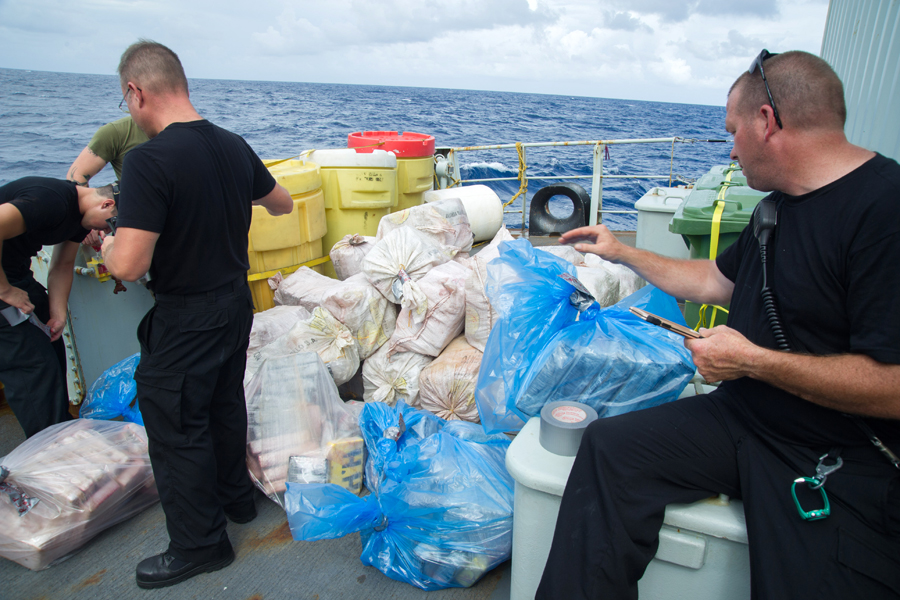Operation Caribbe: Smugglers Blues
By Lookout on Nov 30, 2017 with Comments 0

Crewmembers from Her Majesty’s Canadian Ship Moncton mark the drug bundles seized by US Coast Guard members on Nov.11 during Operation Caribbe. Photo by 12 Wing Imaging Services
Peter Mallett, Staff Writer ~
Editor’s Note: For operational security reasons, military members deployed on Operation Caribbe cannot be identified.
When HMCS Nanaimo contributed to the seizure of approximately 480 kilograms of cocaine last month in the eastern Pacific it marked a successful operational moment that was months in the making.
While the high-profile drug bust went down in a matter of hours and got most of the attention, it was the coordinated international effort and several weeks of training that is the real achievement, says the ships’ commanding officer.
“Successful boardings and interdictions are rarely the actions of a single unit or ship; instead, there are aircraft, shore agencies, and other sea consorts that are all critical to the successful capture of illicit product,” he says. “The operation stands as an excellent example of international cooperation and coordination.”
The Kingston-class warship and its crew are participating in Operation Caribbe, Canada’s component in a United States-led, anti-drug trafficking operation known as Operation Martillo.
Also embarked in Nanaimo are members of United States Coast Guard (USCG) law enforcement detachment (LEDET).
How it all went down
Just before midnight on Oct. 30, Nanaimo received a dispatch from a Maritime Patrol Aircraft that directed them to their target, a small Panga-style fishing boat. The minor warship then pursued and brought the Panga to a halt. The two vessels remained stopped in the water until the U.S. Coast Guard’s law enforcement detachment received permission to board the vessel.
“Many people think an event like this plays out like a Tom Clancy novel and it’s a kinetic thing done very quickly, but it is not,” says the Commanding Officer. “Once you identify a vessel you move in on it and then stop the vessel, but the coast guard still needs to go through the process and build a case that there is a reason to board the ship.”
The evidence found offered validation that the information received from government intelligence agencies about the shipment was correct. Law enforcement detachment members embarked on the ship’s Rigid-Hulled Inflatable Boat and boarded the Panga to complete the seizure.
What they found was approximately $33,000 (U.S.) worth of cocaine packaged in one-kilogram bricks that were layered in a false deck within the vessel. The suspected smugglers were then transported to a USCG cutter on patrol in the region, and Nanaimo resumed operations.
The ship’s commanding officer, who has participated in similar deployments including one aboard HMCS Whitehorse in 2015, says it is common for most vessels to jettison their cargo or evade capture once they identify a government vessel in the vicinity. He says this situation late last month was unique because the vessel in question was observed in a nearly stationary position for several hours.
“It is unclear whether these smugglers were experiencing engine trouble or had failed to spot Nanaimo and were waiting for another contact or transfer vessel to arrive on the scene,” he says, while noting the seizure was made difficult because it occurred in the darkness of night, which hampered visibility.
Readiness Dependent
The nature of the deployment – thwarting the movement of illicit drugs and organized criminal activity – and performing it in an ocean environment presents an “elevated risk,” says Nanaimo’s Commanding Officer.
It is the preparation and mission readiness of his crew, a mix of Reservist and Regular Force members, that is crucial to mission success.
“The point of making sure we practice and have everyone familiar with the processes of living and working on a ship is a big component of making things work,” he explains.
After leaving Esquimalt Harbour Sept. 28 Nanaimo’s crew performed workups without the assistance of another minor warship, only the second time that has happened.
Embarked Sea Trainers worked the crew through tasks such as damage control and force protection before arriving in San Diego Oct. 10.
There they performed a PASS Exercise, where Nanaimo and ships and aircraft from the United States and Mexico sailed in formation, and conducted an exchange of personnel, an effort of cross-decking that gives navies an understanding of what life is like on the other nation’s warship.
Readiness also involves mining the internet and other sources for information about the drug cartels.
“It’s important to gain a geopolitical understanding, and an understanding of the drug cartels themselves and the types of people you are dealing with,” he adds.
Meanwhile on the East Coast
On the East Coast, Halifax-based HMCS Moncton is also deployed on Operation Caribbe in the Caribbean Sea. It has also had a triumphant win on thwarting illicit drugs.
On Nov. 11, the Kingston-Class warship worked with a USCG law enforcement detachment to seize approximately 835 kilograms of cocaine and apprehend three suspected smugglers.
Lieutenant-General Steven Bowes, Commander of Canadian Joint Operations Command, praised the sailors and law enforcement officials for their work.
“The Royal Canadian Navy’s sailors continue to demonstrate excellence in operations around the world,” he said. “Operation Caribbe’s successes are a result of the partnership between allied forces and our collective dedication to keeping our sea lanes safe from illicit activity while also preventing illegal drugs from entering North America.”
Filed Under: Top Stories
About the Author:





